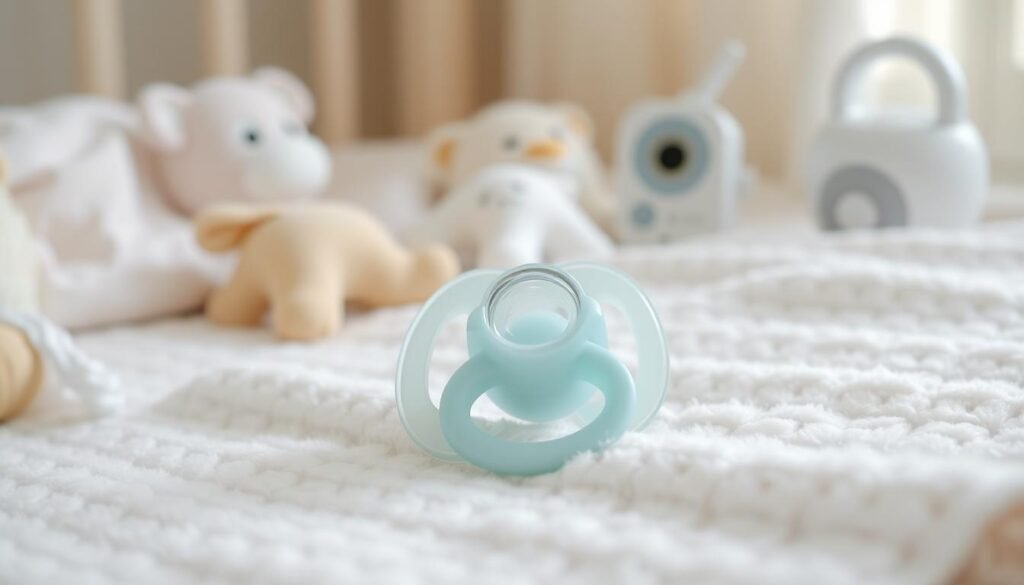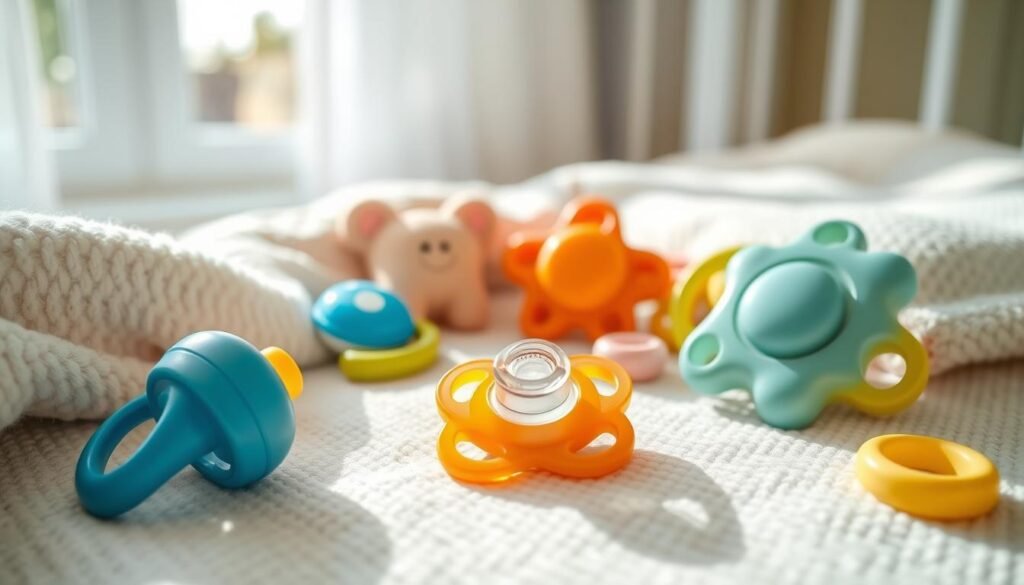Babies are born with a natural urge to suck. Pacifiers can be a soothing tool for newborns and infants. These small silicone nipples can lower a baby’s heart rate and stress levels.
Pacifiers provide comfort and relaxation for babies. They can also reduce the risk of sudden infant death syndrome (SIDS) during sleep. However, it’s vital to use pacifiers safely and responsibly.
Misuse of pacifiers can cause dental and speech problems. It may even lead to ear infections. Parents should learn the benefits and best practices of using baby pacifiers.
Table of Contents
ToggleKey Takeaways
- Pacifiers can provide soothing and calming effects for infants, helping to lower stress levels.
- Pacifier use may decrease the risk of sudden infant death syndrome (SIDS) when used during sleep.
- Proper introduction and responsible use of pacifiers are crucial to avoid potential dental, speech, and ear health issues.
- Pediatricians can guide parents on when and how to safely wean a baby off of pacifiers.
- Choosing age-appropriate, high-quality pacifiers made from premium materials like silicone is recommended.
Benefits of Using a Pacifier
Pacifiers offer many advantages for your baby. They soothe and calm infants while reducing the risk of sudden infant death syndrome (SIDS). These simple tools can greatly improve your baby’s well-being.
Soothing and Calming Effects
Babies have a strong sucking reflex. Pacifiers tap into this instinct, helping to soothe fussy infants. They can lower a baby’s heart rate, blood pressure, and stress levels.
This calming effect promotes relaxation and comfort. It’s especially helpful during medical procedures or when putting your baby to sleep.
Reduced Risk of SIDS
The American Academy of Pediatrics recommends pacifiers at nap and bedtime. They can reduce the risk of sudden infant death syndrome (SIDS) by up to 90%.
Sucking on a pacifier during sleep keeps a baby’s airway open. This lowers the chance of dangerous breathing interruptions. Pacifiers are crucial for safeguarding your baby’s health.
“Pacifiers can soothe a fussy baby and offer temporary distraction, especially helpful during medical procedures.”
| Benefit | Description |
|---|---|
| Soothing and Calming Effects | Pacifiers can lower a baby’s heart rate, blood pressure, and stress levels, promoting relaxation and comfort. |
| Reduced Risk of SIDS | Using a pacifier at nap time and bedtime can reduce the risk of sudden infant death syndrome (SIDS) by up to 90%. |
When to Introduce a Pacifier
Timing matters when introducing a pacifier or “dummy” to your baby. For breastfed babies, wait 3-4 weeks until nursing is well-established. This ensures the pacifier doesn’t disrupt latching or feeding.
After Breastfeeding is Established
Studies show pacifiers don’t significantly impact breastfeeding frequency or duration up to four months. Offer the pacifier between feedings, not to delay them. This approach works for both early and later introduction.
For Non-Breastfed Babies
Non-breastfed babies can use pacifiers from birth. Dummies suit newborns, three-month-olds, or even six-month-olds. Each baby’s reaction varies based on their unique preferences.
Watch your baby’s cues to gauge their readiness for a pacifier. Observe how they engage with it to determine acceptance.
Choose when to introduce a pacifier based on your baby’s needs. Understanding pacifier and breastfeeding recommendations helps you make informed decisions. This knowledge supports your baby’s overall well-being.
Choosing the Right Pacifier
Selecting the perfect pacifier for your baby is crucial. Look for age-appropriate designs made from high-quality materials. Pacifiers come in various styles to suit different developmental stages.
A premium silicone pacifier is often the best choice. Silicone is durable, non-toxic, and easy to clean.
Age-Appropriate Designs
Different pacifier designs can affect your baby’s development. Anatomical pacifiers have a round, slightly elongated teat with a flat base. Teardrop pacifiers, also called orthodontic or physiological pacifiers, have a flat, wider teat.
Cherry pacifiers or round teat pacifiers are less recommended. They may impact a baby’s bite development more than other types.
Premium Silicone Materials
Silicone pacifiers are often better than rubber ones. They’re more durable, non-toxic, and easier to clean. Silicone is also softer and more comfortable for a baby’s skin.
Choose a pacifier with a thin, flat connection between base and teat. This design can help protect your baby’s bite development.
| Pacifier Type | Key Features | Recommendation |
|---|---|---|
| Anatomical Pacifier | Round, slightly elongated teat with flat base and narrower end | Recommended |
| Teardrop Pacifier | Flat, wider teat resembling an inverted drop of water | Recommended |
| Cherry Pacifier | Largest and completely round or only at the tip | Least recommended |
Choosing a pacifier with a thin and flat connection between the base and teat can help reduce the risk of affecting the baby’s bite.
Keeping Pacifier Use Safe
Proper hygiene is vital for pacifier safety. Clean pacifiers daily with warm, soapy water. Check the nipple for wear and tear to prevent choking hazards.
Cleaning and Inspection
Clean your baby’s pacifier after each use. Use mild soap and warm water, then rinse thoroughly. Keep multiple pacifiers on hand for rotation and cleanliness.
Examine the pacifier’s nipple regularly. Look for cracks, tears, or discoloration. Replace the pacifier if you spot any damage.
Avoiding Potential Hazards
- Never dip a pacifier in honey, syrup, or other sweet substances, as this can lead to tooth decay and other health issues.
- Avoid tying the pacifier to your baby’s crib, stroller, or clothing, as this could pose a strangulation risk.
- Choose a pacifier that is one piece, without detachable parts, to reduce the risk of choking.
Follow these safety guidelines for safe and healthy pacifier use. Your baby’s well-being is the top priority.

“Pacifiers can be a great tool for soothing and comforting babies, but it’s crucial to use them safely and responsibly.”
| Safety Tip | Recommendation |
|---|---|
| Cleaning | Wash pacifiers with warm, soapy water daily |
| Inspection | Check for signs of wear and replace if damaged |
| Hazards to Avoid |
|
baby pacifier
Baby pacifiers, or binkies, are nipple-shaped devices for babies’ sucking reflex. They comfort newborns, infants, and young toddlers. These tools offer soothing benefits for little ones.
The American Academy of Pediatrics says pacifiers during sleep can reduce SIDS risk. Studies show they don’t interfere with successful breastfeeding, contrary to popular belief.
When picking an baby pacifier, infant pacifier, or newborn pacifier, consider age, preferences, and materials. Silicone pacifiers often last longer than latex ones.
Use pacifiers safely and watch their use as the child grows. Clean, inspect, and wean properly for a positive experience.
“Pacifiers can be a helpful tool to soothe and comfort babies, but it’s important to use them safely and transition away from them as the child grows older.”
Baby pacifiers, infant pacifiers, and newborn pacifiers can be valuable for parents. They offer comfort and soothing benefits. Understanding proper use helps parents make informed decisions for their child.
Pacifier and Teething
Teething usually starts around six months old. A pacifier can soothe your baby during this time. It helps ease gum pain and distracts from discomfort.
Avoid dangerous teething products like necklaces, amber beads, and numbing gels. These can harm your baby. Instead, try safer options for teething relief.
Breastfeeding can calm your baby and ease pain. Teething toys made of food-grade rubber are safe. Gently massaging the gums with a clean finger also helps.
- Teething necklaces and amber beads are unsafe due to the risk of strangulation and choking hazards.
- Tooth-numbing gels containing benzocaine can cause life-threatening health problems in infants under two years old.
- Breastfeeding can help calm an anxious baby and provide pain relief during the teething process.
- Teething toys made of safe, food-grade materials can apply gentle pressure to soothe inflamed gums.
Pacifiers can help with teething discomfort. But watch out for too much use. Excessive sucking may cause dental issues. Ask your pediatrician about safe teething treatments.
| Teething Remedies | Safety Considerations |
|---|---|
| Pacifier | Gentle sucking motion can soothe gums |
| Breastfeeding | Calms and provides pain relief |
| Teething toys | Made of safe, food-grade materials |
| Gum massage | Using a clean finger |
| Teething necklaces | Pose strangulation and choking hazards |
| Benzocaine gels | Dangerous for infants under 2 years old |
Learn about different teething remedies and their effects. This knowledge helps you make smart choices for your baby. Use pacifiers safely to comfort your teething little one.

Transitioning to Bottle Feeding
Pacifiers can ease a baby’s switch from breast to bottle. They mimic the familiar sucking motion, helping babies adapt. However, careful management is crucial to avoid feeding issues.
Easing the Transition
Wait until breastfeeding is established before introducing a bottle, usually around 4-6 weeks. This helps prevent nipple confusion, where babies struggle switching between breast and bottle.
Introduce the bottle gradually, offering it for one or two feedings daily. Avoid abruptly switching to bottle-feeding.
If the baby refuses, try different bottle types and nipple shapes. Offer the bottle when the baby is calm and alert. Patience and consistency are key when transitioning from pacifier to bottle.
“Around half of pediatricians and postpartum nurses agree that using bottles or pacifiers can cause nipple confusion.”
Consider cup feeding or syringe feeding if bottle refusal persists. Seeking advice from a lactation consultant can be helpful.
The goal is a smooth, stress-free transition for both baby and parents. With patience and support, babies can successfully switch to bottle-feeding.
Weaning Off the Pacifier
It’s time to help your child let go of their pacifier. Experts suggest doing this between ages 2 and 4. Some dentists recommend weaning by age 3. Choosing the right time and method can make this easier for everyone.
When to Start Weaning
Start weaning around 6 months, before your child becomes too attached. This can prevent dental problems and ear infections. Many toddlers still find comfort in pacifiers, making weaning more challenging.
Gradual Weaning Techniques
- Limit pacifier use to specific times, such as naps and bedtime.
- Provide alternative comfort objects, like a soft toy or blanket, to help ease the transition.
- Gradually reduce the size of the pacifier over time, making it less appealing.
- Employ the “cold turkey” method, where all pacifiers are removed at once, coupled with patience and empathy as the child adjusts.
- Utilize distractions and positive reinforcement to encourage the child to self-soothe without the pacifier.
Weaning time varies depending on the child’s attachment and the method used. A plan tailored to your child’s age and personality often works best.
Follow expert advice and use gradual techniques to help your child transition. This approach supports healthy dental and speech development. Your child can successfully move on from their pacifier with your guidance.
Potential Drawbacks of Prolonged Use
Pacifiers can soothe babies, but extended use may cause problems. Research links excessive pacifier use to ear infections in 6-24 month-old infants. Long-term use can affect dental and speech development.
It may lead to issues like overbite, crossbite, and delayed speech. These risks highlight the importance of monitoring pacifier use as babies grow.
Ear Infections
Health organizations suggest limiting pacifier use after six months. This helps reduce the risk of otitis media. Studies show higher risks of ear infections in daycare children using pacifiers.
Dental and Speech Development
Children using pacifiers beyond 24 months may develop dental issues like malocclusion. These effects become more significant after 48 months of use. The AAFP and AAPD recommend stopping pacifier use after age four.
Prolonged pacifier use can delay oral motor development. It may negatively impact speech and language skills, especially in children over 2-3 years old. Parents should consider these factors when deciding on pacifier use.
FAQ
What are the benefits of using a pacifier?
Pacifiers soothe babies, lowering their heart rate and stress levels. They also reduce the risk of SIDS by up to 90%. The American Academy of Pediatrics recommends offering pacifiers at naptime and bedtime.
When should I introduce a pacifier to my baby?
Wait until breastfeeding is well-established, usually around 3-4 weeks. For bottle-fed babies, you can introduce a pacifier anytime.
How do I choose the right pacifier for my baby?
Pick an age-appropriate pacifier made from high-quality materials. Premium silicone pacifiers are better than rubber ones. They’re more durable, non-toxic, and easier to clean.
How do I keep pacifier use safe?
Wash pacifiers daily with soap and water. Check the nipple for wear or damage regularly. Avoid dipping pacifiers in harmful substances.
Never tie a pacifier to the crib or hang it around the baby’s neck. This can cause choking.
What are the potential drawbacks of prolonged pacifier use?
Overuse can increase ear infection risk in babies 6-24 months old. It may also affect dental and speech development. This can lead to overbite, crossbite, and delayed speech.
How can a pacifier help during the teething process?
Pacifiers can provide pain relief and distraction for teething babies. However, monitor use to avoid potential dental issues from prolonged sucking.
How can a pacifier help when transitioning from breastfeeding to bottle feeding?
Pacifiers can ease the switch from breast to bottle. Their familiar shape helps babies adapt to bottles. Manage pacifier use carefully to avoid feeding habit issues.
When should I start the weaning process for my child’s pacifier?
Most kids are ready to give up pacifiers between 2 and 4 years old. Start weaning around 6 months old.
Use gradual techniques like limiting pacifier use to specific times. Provide alternative comfort objects to help ease the transition.

